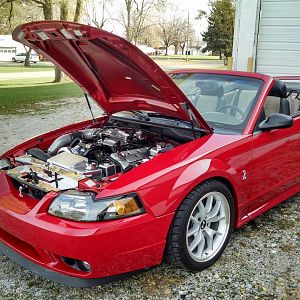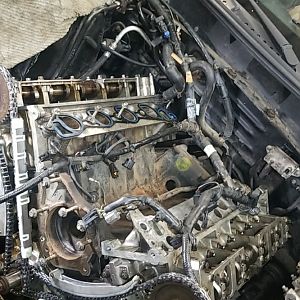G
GREG@SN95
Guest
This article will hopefully explain how to easily adjust the stock clutch in your Mustang. Many people think that all they can do is use the self-adjust mechanism as described in the owner’s manual and then live with that, or else buy an aftermarket adjustable clutch cable or some other device. Well, that is not exactly true, since the stock clutch setup is completely adjustable so the clutch can be made to release or engage at any point in the pedal travel.
Reasons you might want to adjust the clutch:
# Clutch is getting worn out
# Clutch pedal has a "dead" or "mushy" feeling to the first part of the travel
# Difficulty shifting (shifter doesn’t move freely, or gears clash, etc)
# Just a preference to set the clutch engagement point where you want it
Obviously each of these reasons can be due to other problems, but since this is a "no cost" modification, you might consider trying it first.
For safety, I strongly recommend that you spend the time getting to know how the clutch and the adjustment mechanism work, so that you will really understand what you are doing. Also, any clutch adjustment should be performed with the engine turned off, transmission in neutral, and the parking brake firmly set.
There are two ways to adjust the clutch, depending on the reason you are adjusting it in the first place. The standard procedure called out in your owner’s manual is to pull the clutch pedal back toward the driver’s seat. Sometimes this is referred to as "lifting" the clutch pedal since it is usually done with the toe of your shoe while you sit in the seat. This activates the self-adjusting mechanism and is generally fine for most people and is the procedure to use as the clutch wears normally.
The second method is the one most performance enthusiasts would probably want to consider, as it allows the clutch to be adjusted so it releases/engages wherever you desire for your particular driving style.
This is one of those jobs that can literally be a pain in the neck if you really want to understand how the stock clutch adjustment mechanism works, since you have to look up under the dash from the throttle pedal’s point of view. But, the actual adjustment can easily be done kneeling next to the car and reaching under the dash once you know the method, this is especially good if you are like me and don't fit under the dash very well.
Now, it is important to understand the basics. Viewed from the driver’s seat, the brake pedal is between the clutch pedal and the throttle pedal. However, looking under the hood you will notice that the clutch cable goes through the "firewall" between the brake booster and the throttle cable.

This picture is taken from the radio’s point of view, looking toward the driver’s side of the car. The dash is removed in this photo along with all of the interior trim that would normally be visible from this angle. It shows the steering shaft (goldish colored), clutch and brake pedals (black - hanging down in the center of the picture). So to the right of the picture is the "firewall" (forward in the car) and to the left would be the driver’s seat. Although the picture does not show the complete quadrant assembly, studying it should help you understand the mechanism. (I found this in the "random pictures from the past" pile in a drawer and hopefully it is good enough, as I really don’t feel like taking the dash apart to get a better picture for this article. If someone has a better picture, feel free to submit it to the Corral and it will be added.)
The clutch pedal is solidly connected to the shaft that comes through the top center of the picture. This shaft is also solidly connected to the steel arm that extends forward and holds the small ratchet mechanism seen in the upper right of the picture (with a clip holding the ratchet to a small shaft on the
steel arm).
Ignore everything else for a moment and just think about what happens when you push the clutch pedal. The pedal moves to the right in this picture, causing the shaft in the top of the picture to rotate counterclockwise, causing the small ratchet mechanism assembly to rotate upward. Once you understand that, then the rest will be easier to follow.
Now would be a good time to define exactly what this "quadrant" thing is that people talk about. A quadrant is just ¼ of a circle. It is the light colored part of this clutch ratchet mechanism that is in the top center of this picture (actually appears to be more like 1/3 of a circle). It has little teeth on its perimeter and is held onto the clutch pedal shaft by the clip that is visible. However, the quadrant is floating on the shaft, as it is not splined to the shaft and does not directly have to rotate with the shaft (this is a very important part of understanding how the mechanism works).
The clutch cable comes through the "firewall" and attaches to the top of the quadrant, in much the same way that the throttle cable attaches to the throttle body. (Unfortunately this section of the quadrant is out of view above the picture.)
Again, think about what happens when you push the clutch pedal. The small ratchet mechanism assembly on the right rotates upward. This small ratchet mechanism has teeth that are meshed with the quadrant’s teeth, causing the quadrant to rotate counterclockwise, pulling the clutch cable. If you have difficulty visualizing all of the motion from the picture and this description, then it may be worthwhile at this point to look at it in your car and push the pedal by hand so you can watch what happens.
Now, let’s look at the two actual adjustment methods.
The first method is the one described in the owner’s manual. If you pull the clutch pedal back toward the driver’s seat, you will be rotating the small ratchet mechanism assembly downward. Looking at the picture, you’ll notice that the small ratchet mechanism will push against a metal "tab", causing the teeth of the small ratchet mechanism to disengage from the teeth of the quadrant. This causes the clutch to self adjust into the normal location. Many people (including me) find that this makes the clutch pedal position annoyingly close to the floor when the clutch engages/disangages.
The second method is the one you are most interested in and you can probably already see what to do if you understand how the whole ratchet/quadrant thing works.
As you may be able to see in the picture (depending on the clarity), hanging down from the quadrant is a part that is somewhat shaped like a hook. If you could push this "hook" upward slightly (basically rotating the quadrant counterclockwise), you should notice the clutch pedal move too. If you could push it up and keep the clutch pedal from moving then you'll probably hear the ratchet click as it engages one tooth higher, causing the pedal position to be "higher" (closer to the driver’s seat) when the clutch engages/disengages. One click is all that I usually do to make a big difference. However, most people have great difficulty pushing the hook upward because of the spring resisting that motion. It is generally much easier to push the clutch pedal in with one hand, hold the hook up with the other hand, then let the clutch pedal back out. This is the same effect, but you have a bit more leverage. Sometimes, just letting clutch pedal back out on its own doesn’t work and you have to pull it back slightly. It can be very difficult to adjust this way if there is not mushiness to the first part of the pedal travel. Hint: when doing this kneeling next to the car, I hold the "hook" up with my right thumb while working the clutch pedal with my left hand.
If you want the clutch to adjust back to normal, then just use the method described in the owner’s manual. It is a handy little reset while you are playing with whole adjusting mechanism if you think you are getting a bit carried away.
Don't go more than one click at a time without driving it to make sure it is where you like it adjusted. If it takes more than one click then maybe something else is not functioning properly. If it takes more than 2 clicks, then something else is certainly wrong. Also, this puts more load on the throwout bearing and can reduce the pressure plate clamping load on the clutch disc. I have adjusted it one click on most Mustangs I’ve driven (lots) and have never experienced any problems. Just make sure you understand what you are doing and the consequences, as you are responsible for any adjustments you make.
Now, once you have it adjusted where you like it, you’ll probably notice that it easily self-adjusts back to normal if you accidentally pull the pedal back. The easiest way to cure this, once you are happy with the new position, is to slightly bend the metal "tab" that pushes on the small ratchet mechanism so that it no longer allows the self-adjuster to function. The one in the picture is actually bent forward just enough to accomplish this.
Reasons you might want to adjust the clutch:
# Clutch is getting worn out
# Clutch pedal has a "dead" or "mushy" feeling to the first part of the travel
# Difficulty shifting (shifter doesn’t move freely, or gears clash, etc)
# Just a preference to set the clutch engagement point where you want it
Obviously each of these reasons can be due to other problems, but since this is a "no cost" modification, you might consider trying it first.
For safety, I strongly recommend that you spend the time getting to know how the clutch and the adjustment mechanism work, so that you will really understand what you are doing. Also, any clutch adjustment should be performed with the engine turned off, transmission in neutral, and the parking brake firmly set.
There are two ways to adjust the clutch, depending on the reason you are adjusting it in the first place. The standard procedure called out in your owner’s manual is to pull the clutch pedal back toward the driver’s seat. Sometimes this is referred to as "lifting" the clutch pedal since it is usually done with the toe of your shoe while you sit in the seat. This activates the self-adjusting mechanism and is generally fine for most people and is the procedure to use as the clutch wears normally.
The second method is the one most performance enthusiasts would probably want to consider, as it allows the clutch to be adjusted so it releases/engages wherever you desire for your particular driving style.
This is one of those jobs that can literally be a pain in the neck if you really want to understand how the stock clutch adjustment mechanism works, since you have to look up under the dash from the throttle pedal’s point of view. But, the actual adjustment can easily be done kneeling next to the car and reaching under the dash once you know the method, this is especially good if you are like me and don't fit under the dash very well.
Now, it is important to understand the basics. Viewed from the driver’s seat, the brake pedal is between the clutch pedal and the throttle pedal. However, looking under the hood you will notice that the clutch cable goes through the "firewall" between the brake booster and the throttle cable.

This picture is taken from the radio’s point of view, looking toward the driver’s side of the car. The dash is removed in this photo along with all of the interior trim that would normally be visible from this angle. It shows the steering shaft (goldish colored), clutch and brake pedals (black - hanging down in the center of the picture). So to the right of the picture is the "firewall" (forward in the car) and to the left would be the driver’s seat. Although the picture does not show the complete quadrant assembly, studying it should help you understand the mechanism. (I found this in the "random pictures from the past" pile in a drawer and hopefully it is good enough, as I really don’t feel like taking the dash apart to get a better picture for this article. If someone has a better picture, feel free to submit it to the Corral and it will be added.)
The clutch pedal is solidly connected to the shaft that comes through the top center of the picture. This shaft is also solidly connected to the steel arm that extends forward and holds the small ratchet mechanism seen in the upper right of the picture (with a clip holding the ratchet to a small shaft on the
steel arm).
Ignore everything else for a moment and just think about what happens when you push the clutch pedal. The pedal moves to the right in this picture, causing the shaft in the top of the picture to rotate counterclockwise, causing the small ratchet mechanism assembly to rotate upward. Once you understand that, then the rest will be easier to follow.
Now would be a good time to define exactly what this "quadrant" thing is that people talk about. A quadrant is just ¼ of a circle. It is the light colored part of this clutch ratchet mechanism that is in the top center of this picture (actually appears to be more like 1/3 of a circle). It has little teeth on its perimeter and is held onto the clutch pedal shaft by the clip that is visible. However, the quadrant is floating on the shaft, as it is not splined to the shaft and does not directly have to rotate with the shaft (this is a very important part of understanding how the mechanism works).
The clutch cable comes through the "firewall" and attaches to the top of the quadrant, in much the same way that the throttle cable attaches to the throttle body. (Unfortunately this section of the quadrant is out of view above the picture.)
Again, think about what happens when you push the clutch pedal. The small ratchet mechanism assembly on the right rotates upward. This small ratchet mechanism has teeth that are meshed with the quadrant’s teeth, causing the quadrant to rotate counterclockwise, pulling the clutch cable. If you have difficulty visualizing all of the motion from the picture and this description, then it may be worthwhile at this point to look at it in your car and push the pedal by hand so you can watch what happens.
Now, let’s look at the two actual adjustment methods.
The first method is the one described in the owner’s manual. If you pull the clutch pedal back toward the driver’s seat, you will be rotating the small ratchet mechanism assembly downward. Looking at the picture, you’ll notice that the small ratchet mechanism will push against a metal "tab", causing the teeth of the small ratchet mechanism to disengage from the teeth of the quadrant. This causes the clutch to self adjust into the normal location. Many people (including me) find that this makes the clutch pedal position annoyingly close to the floor when the clutch engages/disangages.
The second method is the one you are most interested in and you can probably already see what to do if you understand how the whole ratchet/quadrant thing works.
As you may be able to see in the picture (depending on the clarity), hanging down from the quadrant is a part that is somewhat shaped like a hook. If you could push this "hook" upward slightly (basically rotating the quadrant counterclockwise), you should notice the clutch pedal move too. If you could push it up and keep the clutch pedal from moving then you'll probably hear the ratchet click as it engages one tooth higher, causing the pedal position to be "higher" (closer to the driver’s seat) when the clutch engages/disengages. One click is all that I usually do to make a big difference. However, most people have great difficulty pushing the hook upward because of the spring resisting that motion. It is generally much easier to push the clutch pedal in with one hand, hold the hook up with the other hand, then let the clutch pedal back out. This is the same effect, but you have a bit more leverage. Sometimes, just letting clutch pedal back out on its own doesn’t work and you have to pull it back slightly. It can be very difficult to adjust this way if there is not mushiness to the first part of the pedal travel. Hint: when doing this kneeling next to the car, I hold the "hook" up with my right thumb while working the clutch pedal with my left hand.
If you want the clutch to adjust back to normal, then just use the method described in the owner’s manual. It is a handy little reset while you are playing with whole adjusting mechanism if you think you are getting a bit carried away.
Don't go more than one click at a time without driving it to make sure it is where you like it adjusted. If it takes more than one click then maybe something else is not functioning properly. If it takes more than 2 clicks, then something else is certainly wrong. Also, this puts more load on the throwout bearing and can reduce the pressure plate clamping load on the clutch disc. I have adjusted it one click on most Mustangs I’ve driven (lots) and have never experienced any problems. Just make sure you understand what you are doing and the consequences, as you are responsible for any adjustments you make.
Now, once you have it adjusted where you like it, you’ll probably notice that it easily self-adjusts back to normal if you accidentally pull the pedal back. The easiest way to cure this, once you are happy with the new position, is to slightly bend the metal "tab" that pushes on the small ratchet mechanism so that it no longer allows the self-adjuster to function. The one in the picture is actually bent forward just enough to accomplish this.









